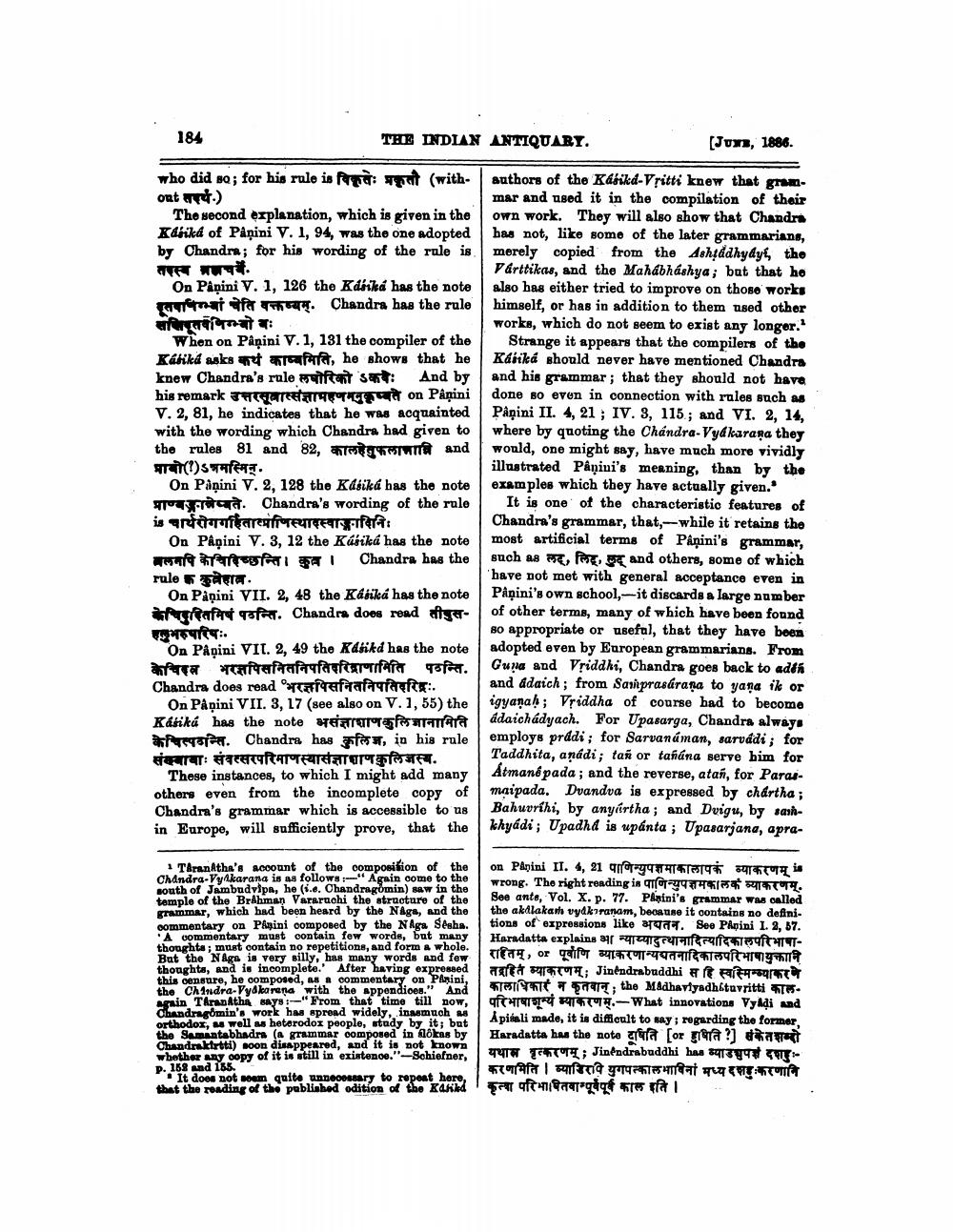________________
184
THE INDIAN ANTIQUARY.
(Jun, 1886.
who did so; for his rule is farta: wait (withont 4.)
The second explanation, which is given in the Kdorika of Påņini V. 1, 94, was the one adopted by Chandra; for his wording of the rule is सरस्व ब्रमच.
On Pipini V. 1, 126 the Kdóiká has the note H e t af men. Chandra has the rule सहिपतर्वनिम्बोपः
When on Pånini V.1, 131 the compiler of the Kalikd asks
far, he shows that he knew Chandra's rule waitftat Sant And by his remark उत्तरसूवात्संज्ञामहणमनुष्यते on Pamini V. 2, 81, he indicates that he was acquainted with the wording which Chandra had given to the rules 81 and 82, g li and प्राबोअमस्मिन.
On Pinini V.2.128 the Katiká has the note T ita Chandra's wording of the rule
चारोगगहितामाणिस्थावस्वानादिनिः On Papini V. 3, 12 the Kúbiká has the note
I I Chandra has the rule SATA On Påņini VII. 2, 48 the Kásiká has the note
afa topat. Chandra does read after of:. On Papini VII. 2, 49 the Kalikd has the note केचिदन भरज्ञपिसनितनिपतिपरिवाणामिति पठन्ति. Chandra does read frafafayfarefcx:.
On Påņini VII. 3, 17 (see also on V. 1, 55) the Katika has the note भसंज्ञाशाणकुलिनानामिति कैचिल्पन्ति . Chandra has कुलिज, in hia rule संक्वाबाः संवत्सरपरिमाणस्यासंज्ञाचाणकुलिजस्व.
These instances, to which I might add many others even from the incomplete copy of Chandra's grammar which is accessible to us in Europe, will sufficiently prove, that the
authors of the Karikd-Vritti knew that grammar and used it in the compilation of their own work. They will also show that Chandra has not, like some of the later grammarians, merely copied from the Ashtadhydy, the Värttikas, and the Mahabháshya; but that ho also has either tried to improve on those works himself, or has in addition to them used other works, which do not seem to exist any longer."
Strange it appears that the compilers of the Kariká should never have mentioned Chandra and his grammar; that they should not have done so even in connection with rules such as Påņini II. 4,21 ; IV. 3, 115; and VI. 2, 14, where by quoting the Chandra-Vyakarana they would, one might say, have much more vividly illustrated Påņini's meaning, than by the examples which they have actually given.
It is one of the characteristio features of Chandra's grammar, that, --while it retains the most artificial terms of Paņini's grammar, such as wa, ow, y and others, some of which have not met with general acceptance even in PAņini's own school,---it discards a large number of other terms, many of which have been found Bo appropriate or useful, that they have been adopted even by European grammarians. From Guna and Vriddhi, Chandra goes back to addh and adaich; from Sariprasarana to yana ik or igyanah; Vriddha of course had to become ádaichádyach. For Upasarga, Chandra always employs prddi; for Sarvanáman, sarvadi; for Taddhita, anádi; tak or tafiána serve him for Atmané pada; and the reverse, atañ, for Parasmaipada. Dvandva is expressed by chartha ; Bahuvrihi, by anyartha; and Dvigu, by sa khyádi; Upadhd is upanta ; Upasarjana, apra
1 TAranAtha's account of the composition of the on Panini II. , 21 -4 149 54 Chandra-Vylkarana is as follows " Again come to the
wrong. The right reading in to y south of Jambudvipa, he (.e. Chandragomin) saw in the
E. temple of the Brahman Vararuchi the structure of the
See ante, Vol. X. p. 77. Panini's grammar was called grammar, which had been heard by the Nage, and the the aktlakam vydkranam, because it contains no defini. commentary on Panini composed by the Naga Sesha. tions of expressions like 99. See Papini L. 2, 87.
A commentary must contain few words, but many Haradatta explains 1915ruturante t thoughta; must contain no repetitions, and form a whole. But the Nage is very silly, has many words and few
राहतम् , or पूर्वाणि व्याकरणान्यपतनादिकालपरिभाषायुक्तानि thoughts, and is incomplete. After having expressed area TL; Jinendrabuddhi RIE this censure, he composed, as a commentary on Panini, the Ch 1ndra-Vydkarena with the appendices." And
HTT T ; the Madhaviyadhtavritti FesAgain Tkranatha says:-"From that time till now, fr 1974 .-What innovations VyAdi and Chandra gmin's work has spread widely. inasmuch as orthodox, well as heterodox people, stady by it; but
A pitali made, it is difficult to say ; regarding the former, the Samantabhadra (a grammar oomposed in Molas by Haradatta has the note a (or gera?) samt Chandraklrtti) soon disappeared, and it is not known whether any copy of it is still in existence."-Schiefner,
48 TTT; Jinendrabuddhi has 89394 P. 168 and 185.
करणमिति | म्यारिरपि युगपत्कालभाविनां मध्य दशःकरणानि It does not som quite unnecessary to repeat here, that the roading of the published odition of the Kalikdy f
6




